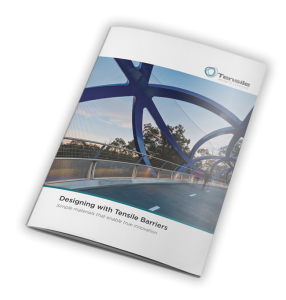Tensile has expertise in designing and installing many types of fall protection. This includes guardrails, safety nets, fences, anti-throw screens and full-length multi-storey barriers.
Our fall protection solutions are always designed according to project requirements in terms of height, engineering, crowd-loads, materials, appearance and compliance with standards and safety codes.
Some of the projects have required bespoke solutions that had never been tried or tested before! But we enjoy a challenge and the opportunity to provide our clients with exactly what they need for fall protection, without compromising on aesthetics.
Fall protection materials
We use Jakob stainless steel materials for our fall protection solutions
Jakob’s Webnet mesh for example is an excellent material for safety barriers and anti-throw screens.
Webnet has robustness and longevity while also being quick to install, flexible, low-maintenance, customisable, and almost transparent in appearance. Its malleable nature makes it adaptable to structures that require a non-uniform or quirkily shaped barrier.
The material also contains around 70% recycled content and is produced in facilities that operate on renewable energy – making it ideal for projects focused on sustainability.
We also use vertical stainless-steel cables for some projects – such as for multi-storey barriers on atriums and staircases. The cables can be extended over several levels, which prevents climbing and jumping, and allows greater use of upper-level spaces.
In many instances, these materials allow for a degree of offsite pre-installation. This reduces disruptions and allows for a more seamless installation process.
Comparing Tensile Solutions to Traditional Fall Protection Options
In comparing Tensile’s innovative barrier solutions like Webnet mesh to traditional materials such as glass, steel, Perspex, chain link, or timber, several advantages emerge.
Tensile’s stainless steel solutions, particularly Webnet, stand out for their durability and low maintenance, contrasting sharply with the fragility of glass and the rust-prone nature of traditional steel.
Unlike Perspex and timber, Webnet does not degrade under UV light or weather conditions, maintaining its aesthetic appeal and structural integrity over time.
Moreover, compared to chain link fences, Webnet offers superior transparency and design flexibility, enhancing the visual openness without sacrificing safety. This integration of form and function is key in modern architectural projects, where the balance between safety, durability, and design aesthetics is essential.

Real-world type of fall protection
Pedestrian bridges
We used Webnet for the pedestrian bridge over Old Bathurst Road at Emu Plains in Sydney, supported on 6mm stainless steel perimeter cables. The Webnet used has an aperture size of 40mm which reduces the risk of climbing and jumping.
The mesh was pre-installed to the bridge off-site, which helped avoid long disruptions over the road and in turn to speed up the project.
The finished result is a fall protection barrier that looks lightweight and almost transparent, yet meets stringent safety codes and Australian Standards for bridges.
Residential buildings
This apartment project in Melbourne involved the use of both Webnet and vertical cables. 100mm Webnet was used for barriers to the common areas and green facade cables for the balconies.
Over time, the climbing plants attached to the cables will grow upwards – creating lush barriers that enhance privacy for residents.
Educational buildings
The new university precinct at Melbourne University was purposely designed to encourage creativity, connection and community. The 30mm Webnet barriers to the balconies reflect this by being almost sculptural in form and highly open and transparent.
Internal stairways
The IAG office building in Sydney required balustrades to 14 internal staircases that would encourage light, airflow and communication between levels – an easy task for Webnet.
The 60mm Webnet panels stretch over two levels at a time – something made possible by the material’s large span capacity.
Carparks and playgrounds
Webnet is ideal for these structures due to its strength and malleability. For example, it can be wrapped around oddly-shaped structures such as playground equipment almost like a piece of fabric – something that wouldn’t be possible with more rigid materials.
Webnet can also wrap around multi-level carparks, which was the case for this installation in Melbourne. This approach helped to prevent costly structural changes and facility closures. The installation also only took three weeks from start to finish – leading to even more savings of time and money.
If you have a project in mind requiring a fall protection solution, we’d love to hear from you. Call us!






































